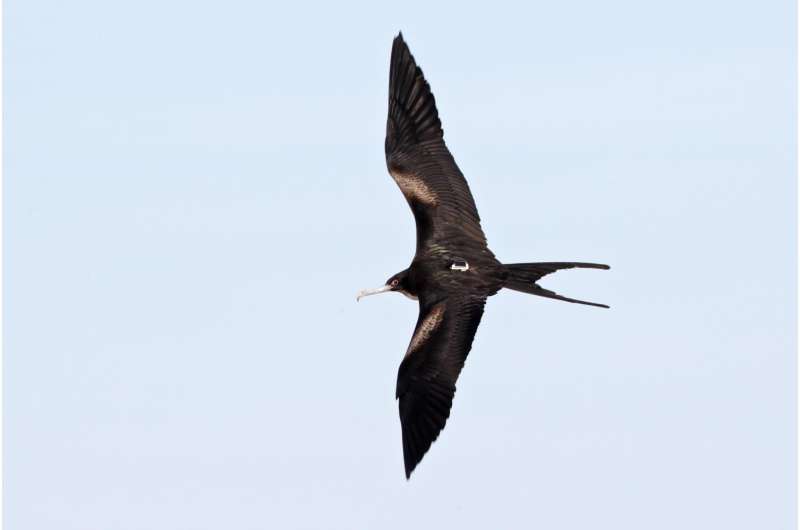Foraging differences let closely related seabirds coexist

How do seabirds share habitat when food is limited? In the case of frigatebirds, size differences drive them to seek different prey. A study in The Auk: Ornithological Advances uses new technology to explore how closely related Great and Lesser frigatebirds manage to coexist at shared breeding colonies where the need to stick close to their nests prevents them from traveling far in search of food.
Past studies have suggested that Great and Lesser frigatebirds have very similar foraging habits, but ecology's "competitive exclusion principle" suggests that they must not be going after exactly the same food, or one would eventually outcompete the other. New advances in GPS tracking and chemical analysis of birds' tissues allowed Rowan Mott of Australia's Monash University and his colleagues to tease out some of the subtle differences that let these species coexist, and they found that the smaller Lesser Frigatebirds were eating prey items from lower on the food chain than their larger relatives, allowing the two species to subsist on the same resource base.
"As I began reading about frigatebirds, it seemed as if Great Frigatebirds and Lesser Frigatebirds share a remarkably similar foraging strategy. This didn't sit well with my understanding of the competitive exclusion principle and niche partitioning theory," says Mott. "It turns out that the two species of frigatebirds seem to have slight differences in their diet that are related to body size. The larger-bodied Great Frigatebird eats more prey from higher levels of the food chain than the smaller-bodied Lesser Frigatebird, and this relationship is particularly strong when comparing the diet of females with the male diet, because females are considerably larger than males."
Mott and his colleagues carried out their research on an island in the Timor Sea, where they captured birds on their nests during the breeding season, fitting them with GPS devices and collecting feathers and blood for isotope analysis. By analyzing the ratios of nitrogen and carbon isotopes in the birds' tissues, the researchers could glean insights into the types of food they had been eating—for example, predatory fish have higher proportion of a certain nitrogen isotope in their bodies, allowing the researchers to make inferences about prey type.
"Ecologists argue that coexistence of similar species can only persist if populations have more resources than they need or if they use different subsets of resources," according to Acadia University's Dave Shutler, a seabird ecologist not involved in the study. "In the latter case, identifying where and how species partition resources can be challenging for mobile species such as birds; using tracking devices and chemical signatures in tissues, Mott and his collaborators have evaluated differences in diets and spatial use of two species of frigatebirds."
More information: "Resource partitioning between species and sexes in Great Frigatebirds and Lesser Frigatebirds" December 7, 2016, americanornithologypubs.org/do … 10.1642/AUK-16-184.1
Provided by The Auk





















